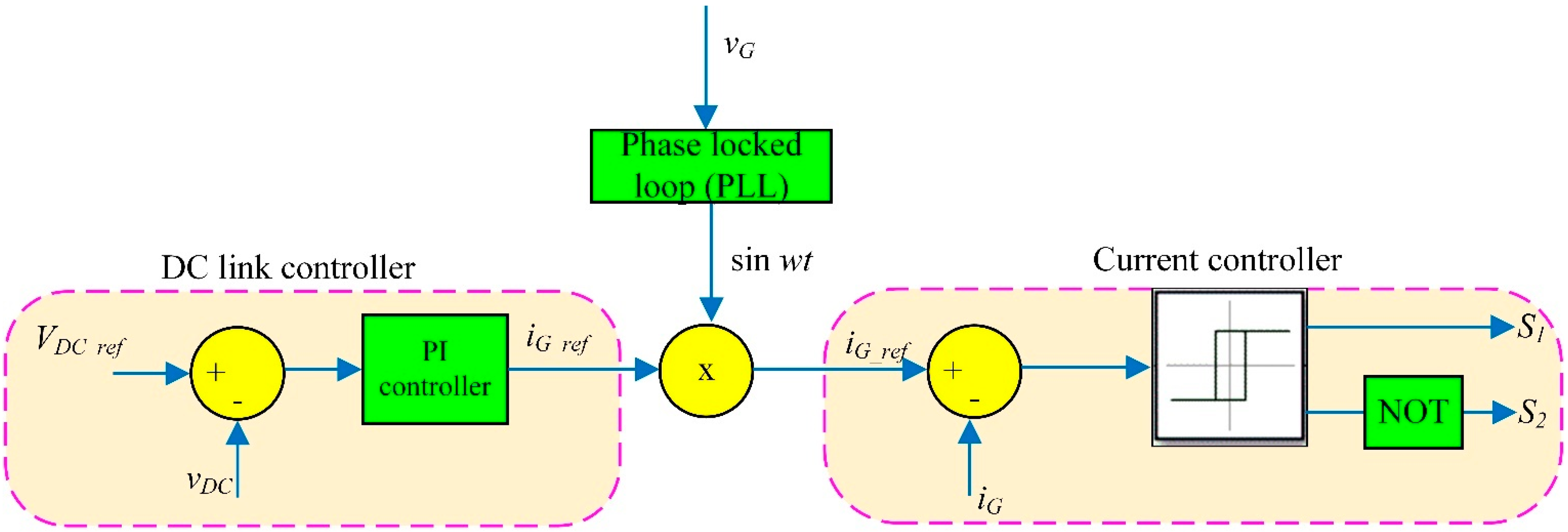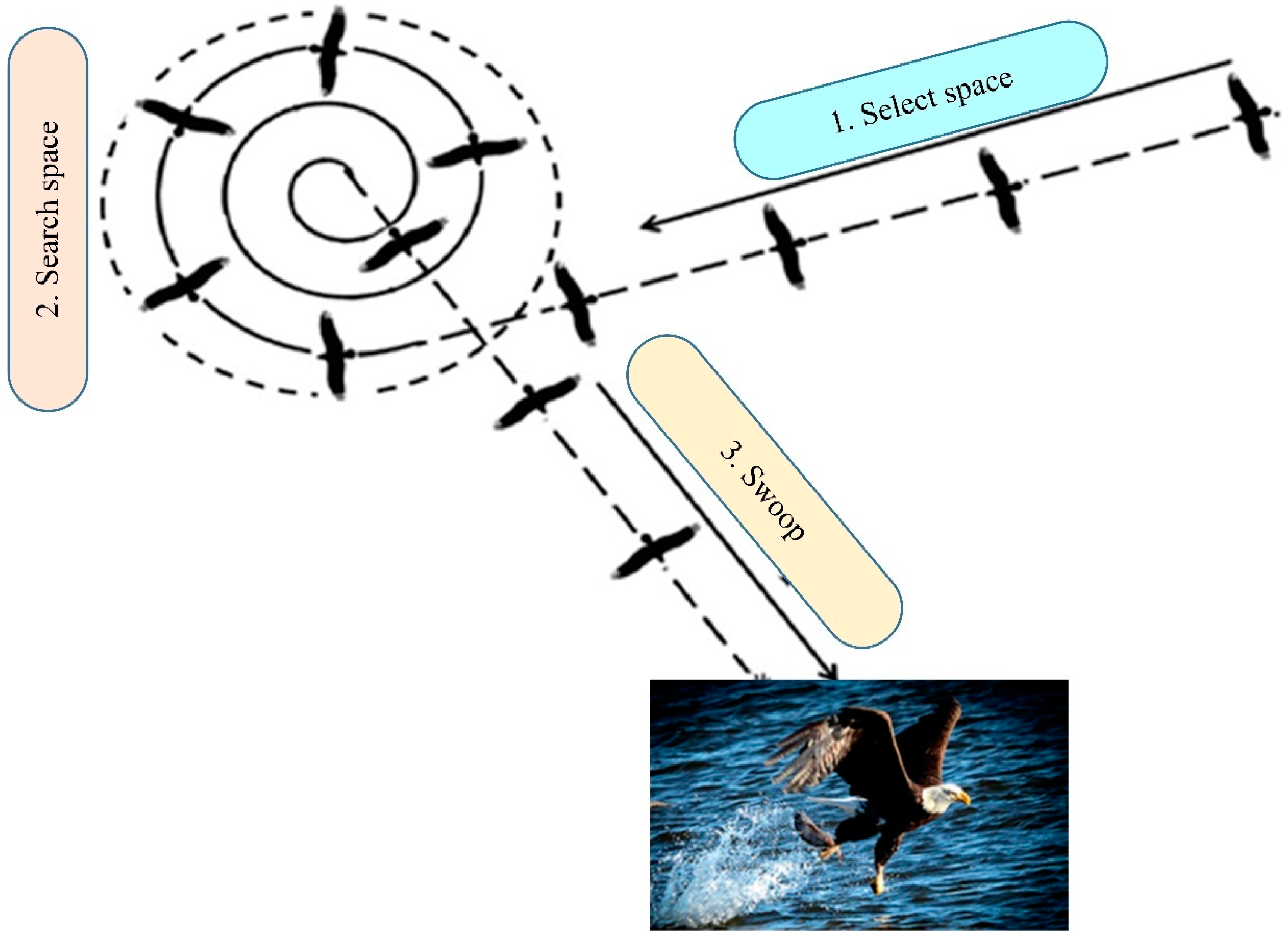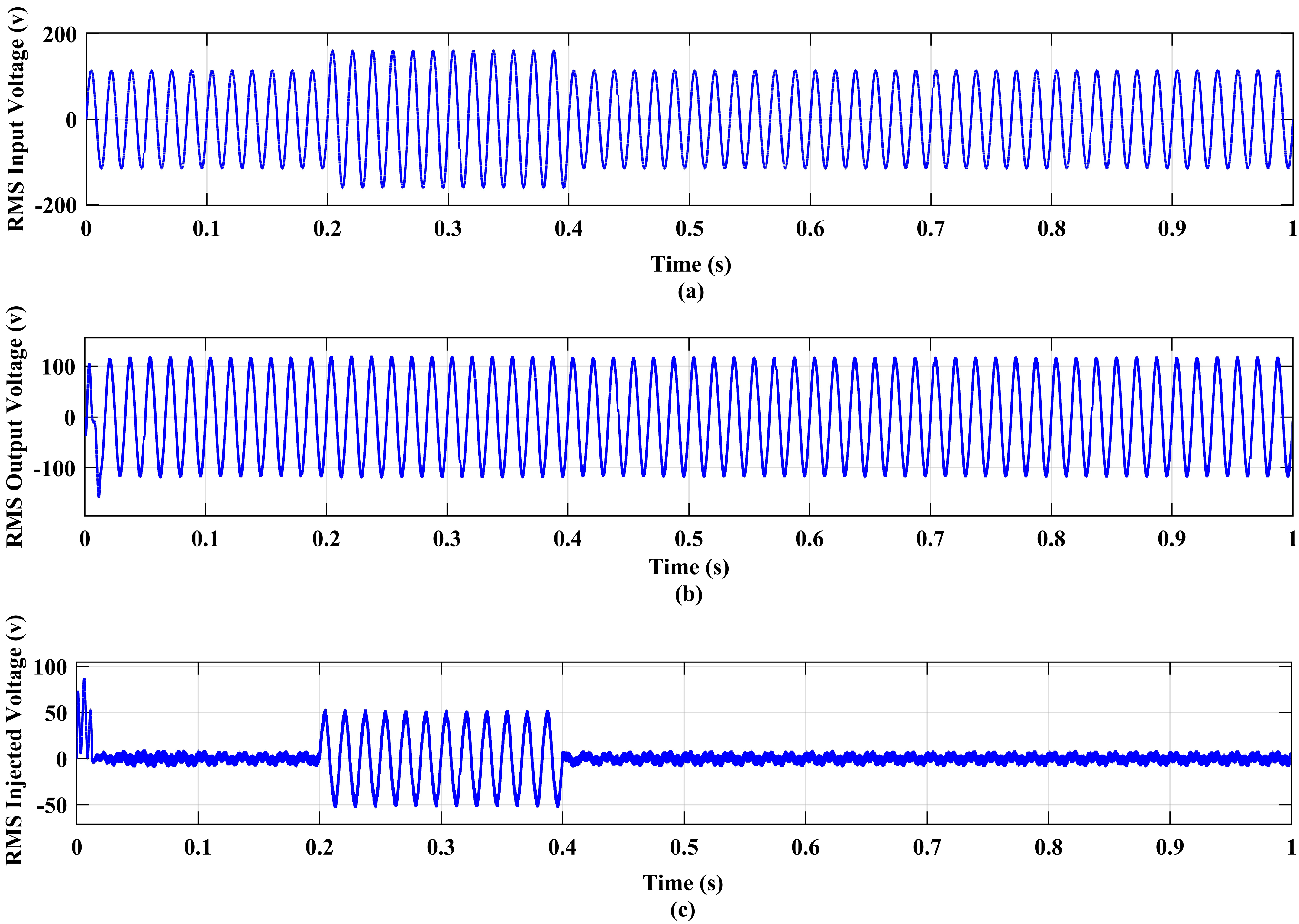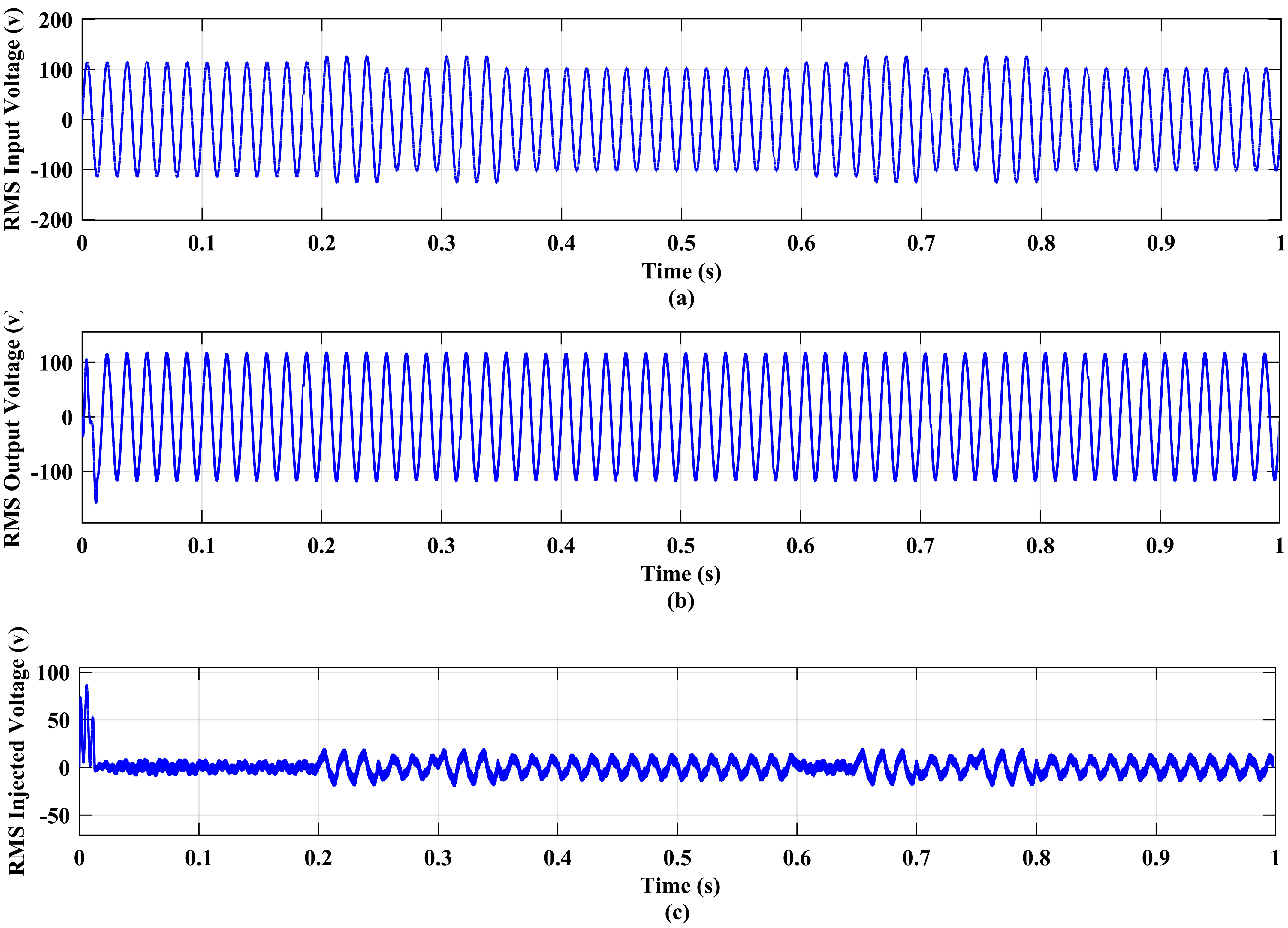Unified Power Quality Conditioner Using Recent Optimization Technique: A Case Study in Cairo Airport, Egypt
Abstract
1. Introduction
- A new TL-UPQC is presented to enhance power quality for LED lighting network in the Cairo airport, Egypt;
- Enhanced Bald Eagle Search Optimization is used for controller circuit to get optimum results from TL-UPQC scheme;
- The effectiveness of the TL-UPQC is verified by showing the waveforms of grid voltage and load voltage in cases of voltage sag, voltage swell, voltage transient, harmonics, and voltage flickering for TL-UPQC system in LED lighting network;
- In addition, a comparison between different optimization techniques CSA, MFO, and SSA is made, and the proposed EBES technique implemented on the PI controller to imitate the actions of the proposed UPQC topology and exhibit the efficiencies and differences in parameters;
- Finally, experimental validations are implemented to verify the proposed TL-UPQC scheme.
2. Case under Study
- Transformerless: No transformer is presented between the grid and the VSC. It has good effects and is economical;
- Low common-mode (CM) voltage: In the absence of a transformer, the parameters CM voltage and leakage current become important. The connection to the bank’s central capacitor may allow the topology to maintain a low CM voltage;
- Simple topology: the topology saves money, lessens the complexity of the controller design, and results in fewer losses; for each power stage, just two active devices are required;
- LED lighting networks with grid voltage transients offer excellent and reliable load voltage;
- It provides current harmonics elimination features.
3. Proposed TL-UPQC Topology
3.1. Principle of Operation
- Verify the sinusoidal and voltage-in-phase nature of the input current;
- Supply LED bulbs with a steady, sinusoidal voltage.
- To maintain a sinusoidal, constant amplitude output voltage, an output voltage controller is used. Additionally, it reacts quickly to transients, such as fluctuations in grid voltage;
- Input current controller—utilized to maintain sinusoidal and in-phase grid current;
- Dc link voltage controller—used to maintain the dc link voltage between two VSCs—assists in result of the optimal balance between input and output power.
3.2. Controller Design and Implementation
Control Methodology of APF
3.3. Control Methodology of DVR
4. Formulation of the Optimization Problem
4.1. Fitness Function
4.2. Constraints
- The second feeder’s voltage level is restricted to the range between its minimum and maximum values, as determined by Equation (26); thus
4.3. Enhanced Bald Eagle Search Optimization Algorithm
4.3.1. Bald Eagles Hunting Strategy
4.3.2. The BES Algorithm
- The first stage (Selection)
- The second stage (Search)
- The third stage (Swooping)
- The Levy function
- Enhanced BES
| Algorithm 1 Initialize the first population. |
| Evaluate the objective function of the initial population. While (the current iteration number < max. number of iterations) Stage 1: Selection of the research space For (each population i < population size) If f() < f() If f() < f() End If End If End for Stage 2: Searching within the selected space For (each population i < population size) If f() < f() If f() < f() End If End If End for Stage 3: Swoop For (each point i in the population) If f() < f() If f() <f () End If End If End for Set k=k+1 End While |
5. Results and Discussion
5.1. Modeling and Simulation
5.2. Case I: Voltage Sag
5.3. Case II: Voltage Swell
5.4. Case III: Voltage Flickering
5.5. Case IV: Voltage Transient
5.6. Case V: Analysis of Harmonic Distortion
5.7. Comparative Study
5.8. TL-UPQC Experimental Validation
6. Conclusions
Author Contributions
Funding
Institutional Review Board Statement
Informed Consent Statement
Data Availability Statement
Conflicts of Interest
Abbreviations
| List of abbreviations | |
| AdaBoost | Adaptive boosting |
| APF | Active power filter |
| BES | Bald Eagle Search |
| BIFRED | Boost integrated flyback rectifier/energy storage dc-dc converter |
| CM | Common mode |
| CSA | Cuckoo search algorithm |
| DSP | Digital signal processors |
| DVR | Dynamic voltage restorer |
| EBES | Enhanced Bald Eagle Search |
| FFCL | Feed-forward control loop |
| HB | Half bridge |
| HBVSI | Half-bridge voltage source inverter |
| LED | Light emitting diode |
| MC-UPQC | Multi-converter unified power quality conditioner |
| MEA-GRNN | Mind evolution algorithm-generalized regression neural network |
| MFO | Moth flame optimization |
| PFC | Power factor correction |
| PI | Proportional integral |
| PLL | Phase-locked loop |
| PQ | Power quality |
| PV | Photovoltaic |
| SSA | Salp swarm algorithm |
| THD | Total harmonic distortion |
| TL-UPQC | Transformerless half-bridge unified power quality conditioner |
| VI | Variable inductor |
| VSC | Voltage source converter |
| ZCS | Zero current switching |
| ZVS | Zero voltage switching |
| List of Symbols | |
| Grid voltage during sag | |
| Inductor current hysteresis ripple band | |
| Inductor current hysteresis ripple band | |
| Best position | |
| Mean position | |
| Switching the ith IGBT | |
| Grid current during sag | |
| Output current during sag | |
| Shunt current during sag | |
| Grid current during swell | |
| Output current during swell | |
| Shunt current during swell | |
| Injected current of DVR | |
| Grid current | |
| Reference grid current | |
| Load’s distorted current | |
| Reactive and harmonic current | |
| Reference inductor current | |
| Constant value | |
| Input power | |
| Output power | |
| Injected voltage during sag | |
| Output voltage during sag | |
| , | Injected voltage during swell |
| Output voltage during swell | |
| Maximum boundary of a reference signal | |
| Minimum boundary of a reference signal | |
| Controlled voltage source | |
| Dc link voltage | |
| Grid voltage | |
| Grid voltage during swell | |
| Load voltage | |
| ∅ | Load phase angle |
| a | Variable parameter |
| c1 | Random parameter |
| c2 | Random parameter |
| R | Variable parameter |
| ΔV | Voltage hysteresis ripple band |
| Levy function factor | |
| Random value | |
| The position change control parameter | |
References
- Adewumi, O.B.; Fotis, G.; Vita, V.; Nankoo, D.; Ekonomou, L. The Impact of Distributed Energy Storage on Distribution and Transmission Networks’ Power Quality. Appl. Sci. 2022, 12, 6466. [Google Scholar] [CrossRef]
- Remigio-Carmona, P.; González-de-la-Rosa, J.-J.; Florencias-Oliveros, O.; Sierra-Fernández, J.-M.; Fernández-Morales, J.; Espinosa-Gavira, M.-J.; Agüera-Pérez, A.; Palomares-Salas, J.-C. Current Status and Future Trends of Power Quality Analysis. Energies 2022, 15, 2328. [Google Scholar] [CrossRef]
- Martinez, R.; Castro, P.; Arroyo, A.; Manana, M.; Galan, N.; Moreno, F.S.; Bustamante, S.; Laso, A. Techniques to Locate the Origin of Power Quality Disturbances in a Power System: A Review. Sustainability 2022, 14, 7428. [Google Scholar] [CrossRef]
- Thentral, T.M.T.; Palanisamy, R.; Usha, S.; Bajaj, M.; Zawbaa, H.M.; Kamel, S. Analysis of Power Quality Issues of Different Types of Household Applications. Energy Rep. 2022, 8, 5370–5386. [Google Scholar] [CrossRef]
- Krishna, D.; Sasikala, M.; Ganesh, V. Adaptive FLC-Based UPQC in Distribution Power Systems for Power Quality Problems. Int. J. Ambient. Energy 2022, 43, 1719–1729. [Google Scholar] [CrossRef]
- Dzhuraev, S.D.; Rahimov, R.A.; Sultonov, S.M.; Nazirov, K.B.; Ganiev, Z.S.; Karimov, R.C. Study and Analysis of Power Quality in the Electrical Networks of the Outdoor Lighting of the Dushanbe City. In Proceedings of the 2022 Conference of Russian Young Researchers in Electrical and Electronic Engineering (ElConRus), Saint Petersburg, Russia, 25–28 January 2022; IEEE: Piscataway, NJ, USA, 2022; pp. 1166–1169. [Google Scholar]
- Meinck, M.; Blanco, A.M.; Kannan, S.; Meyer, J.; Pavas, A. Harmonic Interaction of LED Lamps in Islanded Microgrids. In Proceedings of the 2022 20th International Conference on Harmonics & Quality of Power (ICHQP), Naples, Italy, 29 May–1 June 2022; IEEE: Piscataway, NJ, USA, 2022; pp. 1–6. [Google Scholar]
- Gil-de-Castro, A.; Rönnberg, S.K.; Bollen, M.H.J. Light Intensity Variation (Flicker) and Harmonic Emission Related to LED Lamps. Electr. Power Syst. Res. 2017, 146, 107–114. [Google Scholar] [CrossRef]
- Phannil, N.; Jettanasen, C.; Ngaopitakkul, A. Harmonics and Reduction of Energy Consumption in Lighting Systems by Using LED Lamps. Energies 2018, 11, 3169. [Google Scholar] [CrossRef]
- Iqbal, M.N.; Kütt, L.; Asad, B.; Shabbir, N.; Rasheed, I. Time-Dependent Variations in Current Harmonic Emission by LED Lamps in the Low-Voltage Network. Electr. Eng. 2021, 103, 1525–1539. [Google Scholar] [CrossRef]
- Abdalaal, R.M.; Man Ho, C.N. Characterization of Commercial LED Lamps for Power Quality Studies. IEEE Can. J. Electr. Comput. Eng. 2021, 44, 94–104. [Google Scholar] [CrossRef]
- Manuel Jesús, H.-O.; Gago-Calderon, A.; Rojas Sola, J.I. Power Quality and Energy Efficiency in the Pre-Evaluation of an Outdoor Lighting Renewal with Light-Emitting Diode Technology: Experimental Study and Amortization Analysis. Energies 2017, 10, 836. [Google Scholar] [CrossRef]
- Wibowo, R.; Suryadi; Priambodo, P.S. Harmonic Testing Analysis of Light Emitting Diode ({LED}) Lamps Based {SNI} {IEC} 61000-3-2 Standard. J. Phys. Conf. Ser. 2021, 1803, 12023. [Google Scholar] [CrossRef]
- Yang, J.; Ma, H.; Dou, J.; Guo, R. Harmonic Characteristics Data-Driven THD Prediction Method for LEDs Using MEA-GRNN and Improved-AdaBoost Algorithm. IEEE Access 2021, 9, 31297–31308. [Google Scholar] [CrossRef]
- Molina, J.; Mesas, J.J.; Mesbahi, N.; Sainz, L. LED Lamp Modelling for Harmonic Studies in Distribution Systems. IET Gener. Transm. Distrib. 2017, 11, 1063–1071. [Google Scholar] [CrossRef]
- Raciti, A.; Rizzo, S.A.; Susinni, G. Circuit Model of LED Light Bulb Suitable for Typical Voltage THD on LV Distribution Networks. Energy Build. 2020, 212, 109665. [Google Scholar] [CrossRef]
- Junior, E.; Stoller, H.; Scofield, P. Análise Experimental de Indicadores de Qualidade de Energia de Lâmpadas LED E27 Residenciais Disponíveis No Mercado Brasileiro. Semin. Ciências Exatas E Tecnológicas 2020, 41, 125. [Google Scholar] [CrossRef]
- Alonso, J.M.; Perdigão, M.S.; Dalla Costa, M.A.; Martínez, G.; Osorio, R. Analysis and Experiments on a Single-Inductor Half-Bridge LED Driver With Magnetic Control. IEEE Trans. Power Electron. 2017, 32, 9179–9190. [Google Scholar] [CrossRef]
- Baek, J.-B.; Chae, S. Single-Stage Buck-Derived LED Driver With Improved Efficiency and Power Factor Using Current Path Control Switches. IEEE Trans. Ind. Electron. 2017, 64, 7852–7861. [Google Scholar] [CrossRef]
- da Motta, L.C.; Agostini, E.; Nascimento, C.B. Single-Stage Converter Based on the Charge-Pump and Valley-Fill Concepts to Drive Power LEDs. IEEE J. Emerg. Sel. Top. Power Electron. 2018, 6, 1131–1142. [Google Scholar] [CrossRef]
- Pouladi, F.; Farzanehfard, H.; Adib, E. Battery Operated Soft Switching Resonant Buck–Boost LED Driver With Single Magnetic Element. IEEE Trans. Power Electron. 2019, 34, 2704–2711. [Google Scholar] [CrossRef]
- Efendi, M.; Murdianto, F.; Fitri, F.; Badriyah, L. Power Factor Improvement on LED Lamp Driver Using BIFRED Converter. TELKOMNIKA (Telecommun. Comput. Electron. Control) 2020, 18, 571. [Google Scholar] [CrossRef]
- Kasi Ramakrishnareddy, C.; Kumar, S.R.; Surya Kalavathi, M. A Buck-Boost Controlled Full Bridge LED Driver with Zero-Voltage Switching. J. Power Technol. 2021, 101, 62–69. [Google Scholar]
- Hsieh, Y.-C.; Cheng, H.-L.; Chang, E.-C.; Huang, W.-D. A Soft-Switching Interleaved Buck-Boost LED Driver with Coupled Inductor. IEEE Trans. Power Electron. 2022, 37, 577–587. [Google Scholar] [CrossRef]
- Abdalaal, R.M.; Ho, C.N.M. Transformerless Single-Phase UPQC for Large Scale LED Lighting Networks. In Proceedings of the IECON 2017—43rd Annual Conference of the IEEE Industrial Electronics Society, Beijing, China, 29 October–1 November 2017; pp. 1629–1634. [Google Scholar]
- Campanhol, L.B.G.; da Silva, S.A.O.; de Oliveira, A.A.; Bacon, V.D. Single-Stage Three-Phase Grid-Tied PV System With Universal Filtering Capability Applied to DG Systems and AC Microgrids. IEEE Trans. Power Electron. 2017, 32, 9131–9142. [Google Scholar] [CrossRef]
- Devassy, S.; Singh, B. Design and Performance Analysis of Three-Phase Solar PV Integrated UPQC. IEEE Trans. Ind. Appl. 2018, 54, 73–81. [Google Scholar] [CrossRef]
- Pappula, S.K.; Malaji, S. Harmonic Mitigation In Multi Feeder Using Multi Converter-Unified Power Quality Conditioning System. In Proceedings of the 2018 8th IEEE India International Conference on Power Electronics (IICPE), Jaipur, India, 13–15 December 2018; pp. 1–6. [Google Scholar]
- Choudhury, S.R.; Das, A.; Anand, S.; Tungare, S.; Sonawane, Y. Adaptive Shunt Filtering Control of UPQC for Increased Nonlinear Loads. IET Power Electron. 2019, 12, 330–336. [Google Scholar] [CrossRef]
- Alsattar, H.A.; Zaidan, A.A.; Zaidan, B.B. Novel Meta-Heuristic Bald Eagle Search Optimisation Algorithm. Artif. Intell. Rev. 2020, 53, 2237–2264. [Google Scholar] [CrossRef]
- Mirjalili, S. Moth-Flame Optimization Algorithm: A Novel Nature-Inspired Heuristic Paradigm. Knowl. Based Syst. 2015, 89, 228–249. [Google Scholar] [CrossRef]
- Yang, X.-S.; Deb, S. Cuckoo Search: Recent Advances and Applications. Neural Comput. Appl. 2014, 24, 169–174. [Google Scholar] [CrossRef]
- Mirjalili, S.; Gandomi, A.H.; Mirjalili, S.Z.; Saremi, S.; Faris, H.; Mirjalili, S.M. Salp Swarm Algorithm: A Bio-Inspired Optimizer for Engineering Design Problems. Adv. Eng. Softw. 2017, 114, 163–191. [Google Scholar] [CrossRef]
- Nicola, M.; Nicola, C.-I.; Sacerdoțianu, D.; Vintilă, A. Comparative Performance of UPQC Control System Based on PI-GWO, Fractional Order Controllers, and Reinforcement Learning Agent. Electronics 2023, 12, 494. [Google Scholar] [CrossRef]
- Alsaidan, I.; Shaheen, M.A.M.; Hasanien, H.M.; Alaraj, M.; Alnafisah, A.S. A PEMFC Model Optimization Using the Enhanced Bald Eagle Algorithm. Ain Shams Eng. J. 2022, 13, 101749. [Google Scholar] [CrossRef]














| Operation Modes | PI Controller | Computation Time (s) | Objective fn. (v) | |
|---|---|---|---|---|
| Kp | Ki | |||
| Case I: Voltage sag | 3.541 | 1.468 | 123.474 | 1.623 |
| Case II: Voltage swell | 3.348 | 0.476 | 120.846 | 1.487 |
| Case III: Voltage flickering | 2.483 | 1.124 | 121.011 | 1.668 |
| Case IV: Voltage transient | 4.731 | 0.471 | 126.282 | 1.689 |
| Parameters | Value |
|---|---|
| Nominal AC voltage | 100 V |
| Grid frequency | 60 Hz |
| DC link voltage | 400 V |
| 10 mH | |
| 3.4 mH | |
| 14.1 μF | |
| 1500 μF |
| Optimization Techniques | CSA | MFO | SSA | Proposed (EBES) |
|---|---|---|---|---|
| Max. iteration | 500 | 500 | 500 | 500 |
| No. of population | 50 | 50 | 50 | 50 |
| Control parameters | r1 and r2 rand in [0, 1] | c1 and c2 rand in [1, 2] | ||
| Computation time (s) | 382.405 | 171.347 | 157.544 | 123.474 |
| J1 (objective function) | 1.983 | 1.865 | 1.797 | 1.623 |
| Kp | 3.7566 | 2.0500 | 2.1261 | 3.541 |
| Ki | 1.8998 | 1.7237 | 1.9391 | 1.468 |
Disclaimer/Publisher’s Note: The statements, opinions and data contained in all publications are solely those of the individual author(s) and contributor(s) and not of MDPI and/or the editor(s). MDPI and/or the editor(s) disclaim responsibility for any injury to people or property resulting from any ideas, methods, instructions or products referred to in the content. |
© 2023 by the authors. Licensee MDPI, Basel, Switzerland. This article is an open access article distributed under the terms and conditions of the Creative Commons Attribution (CC BY) license (https://creativecommons.org/licenses/by/4.0/).
Share and Cite
Abdel Mohsen, S.E.; Ibrahim, A.M.; Elbarbary, Z.M.S.; Omar, A.I. Unified Power Quality Conditioner Using Recent Optimization Technique: A Case Study in Cairo Airport, Egypt. Sustainability 2023, 15, 3710. https://doi.org/10.3390/su15043710
Abdel Mohsen SE, Ibrahim AM, Elbarbary ZMS, Omar AI. Unified Power Quality Conditioner Using Recent Optimization Technique: A Case Study in Cairo Airport, Egypt. Sustainability. 2023; 15(4):3710. https://doi.org/10.3390/su15043710
Chicago/Turabian StyleAbdel Mohsen, Sally E., Ahmed M. Ibrahim, Z. M. Salem Elbarbary, and Ahmed I. Omar. 2023. "Unified Power Quality Conditioner Using Recent Optimization Technique: A Case Study in Cairo Airport, Egypt" Sustainability 15, no. 4: 3710. https://doi.org/10.3390/su15043710
APA StyleAbdel Mohsen, S. E., Ibrahim, A. M., Elbarbary, Z. M. S., & Omar, A. I. (2023). Unified Power Quality Conditioner Using Recent Optimization Technique: A Case Study in Cairo Airport, Egypt. Sustainability, 15(4), 3710. https://doi.org/10.3390/su15043710








